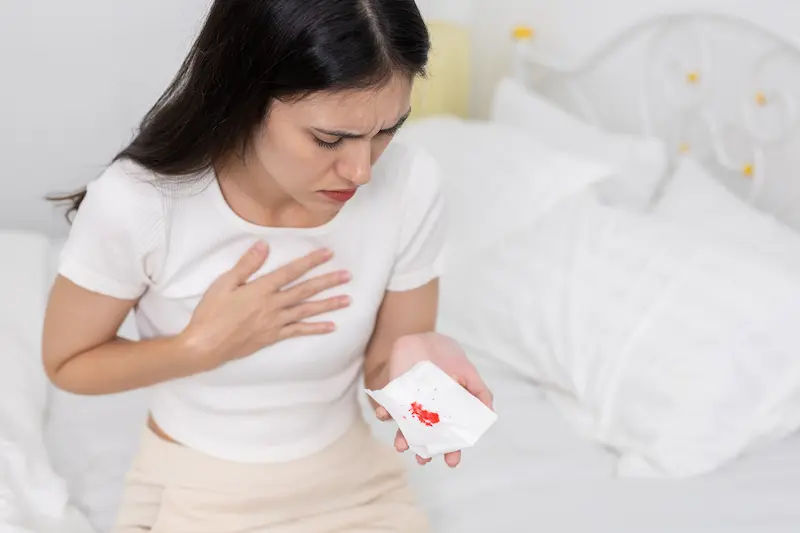Guide to What To Do If You Notice Blood In Your Cough20
Coughing up blood, known as haemoptysis, can range from harmless irritation to a sign of serious lung disease. This comprehensive medical guide explains causes, warning signs, when to seek emergency care, and how doctors diagnose and manage symptoms. Learn the correct steps to protect your health.


Haemoptysis refers to blood coming from the lungs or airways during coughing.
Spotting blood mixed with phlegm can prompt immediate concern, and correctly identifying whether the source is truly the lungs is vital. Haemoptysis varies widely — from streaks of blood following a viral chest infection to significant bleeding requiring urgent intervention. Minor cases often resolve without complications as airway tissues heal. Still, recognising what constitutes haemoptysis, and distinguishing it from blood that originates elsewhere, is essential for safe decision-making.
Consult a Top Pulmonologist for Personalised Advice
What counts as haemoptysis vs. blood-tinged mucus
- Blood-tinged mucus: small streaks or dots of blood combined with sputum due to airway irritation.
- Haemoptysis: more conspicuous bleeding, including clots or clearly blood-coloured sputum.
In many cases, infection-related inflammation increases the fragility of airway blood vessels. Repeated coughing and friction can cause minor bleeding near the trachea or bronchi.
Coughing blood vs. vomiting blood vs. nosebleed drainage
- Haemoptysis usually produces frothy, bright or rusty-coloured sputum. Breathing symptoms are commonly present.
- Vomiting blood (haematemesis) appears darker, sometimes clotted or mixed with food, and is preceded by nausea or abdominal discomfort.
- Pseudohaemoptysis occurs when blood from the nose or gums is swallowed or drains backward and is then coughed up.
Colour clues
- Bright red, bubbly blood suggests airway bleeding.
- Rust-coloured sputum is common in pneumonia.
- Pink, frothy sputum may indicate pulmonary oedema — a medical emergency.
Approach every instance with caution and seek professional advice if uncertain.
When to Seek Care: Emergencies vs. Watch-and-See
Warning signs help you decide whether to seek immediate medical assistance.
Most mild haemoptysis improves quickly, particularly when caused by infections clearing up. However, urgent attention
is crucial if breathing becomes compromised or bleeding increases.
Red flags — seek emergency help immediately
- More than a few teaspoons of blood, or repeated mouthfuls
- Breathlessness, chest pain, dizziness, or fainting
- Pink, frothy sputum with sudden respiratory distress
- Known chronic lung disease with a sudden increase in bleeding
- Recent chest trauma
- Suspected pulmonary embolism: new chest pain or breathlessness with coughing blood
- Active bleeding while taking anticoagulants
How to judge the amount — simple practical measure
Household measures help approximate volume:
- Teaspoon ≈ 5 mL
- Tablespoon ≈ 15 mL
- Shot glass ≈ 30 mL
Filling more than a couple of tablespoons or frequent episodes of fresh blood over minutes must be treated as urgent.
While waiting for emergency help
- Sit upright and lean forward to avoid aspiration of blood.
- Continue coughing out blood rather than swallowing it.
- If one lung is known to bleed, lie on the affected side to protect the healthy lung.
- Avoid new medications, especially aspirin or NSAIDs.
- Have medical details and blood thinner information ready if relevant.
Milder streaking without red flag symptoms should still prompt same-day clinical review. If symptoms persist beyond two weeks, speak with a clinician on Apollo 24|7 for guidance.
Common Causes of Blood in Cough Across Ages
Infections are the most frequent causes, but several conditions require specialised care.
Haemoptysis arises when blood vessels in the airways become inflamed, damaged, or obstructed. The likelihood of each
cause depends on age, smoking history, medication use, and regional disease patterns.
Respiratory infections
- Acute bronchitis commonly leads to small streaks of blood due to persistent cough.
- Pneumonia creates inflamed lung tissue that can bleed, often with fever and chest discomfort.
- Tuberculosis (TB) causes chronic cough, weight loss, night sweats, and recurring haemoptysis in susceptible individuals or high-prevalence regions.
Chronic lung conditions
- Bronchiectasis: widened, damaged airways collect thick mucus and bleed intermittently, particularly during exacerbations.
- COPD or severe asthma: sustained airway inflammation and forceful coughing may cause small vessel injury.
Obstruction, malignancy, and clots
- Pulmonary embolism can trigger sudden chest pain, severe breathlessness, and blood-streaked sputum.
- Lung cancer may present with persistent cough, weight loss, and unexplained haemoptysis, especially in smokers.
- Less common causes include fungal infections, autoimmune diseases like vasculitis, trauma, cystic fibrosis, and abnormal vascular growths.
Medications and blood disorders
- Anticoagulants and antiplatelets make even a minor airway bleed more noticeable.
- Coagulation abnormalities, whether medical or congenital, increase bleeding risk.
A brief oral examination may reveal bleeding gums or dental disease that mimics haemoptysis — yet if in doubt, clinical evaluation is essential.
How Doctors Find the Cause: Tests and What to Expect
Evaluation identifies whether the bleeding originates in the lungs and determines the underlying condition.
A structured assessment helps clinicians decide which investigations are needed.
History and clinical examination
You may be asked about:
- Duration of symptoms and estimated bleeding volume
- Fever, breathlessness, chest pain, weight loss, or night sweats
- TB exposure, smoking, occupational risks, travel history
- Medications such as anticoagulants
- Nose or mouth bleeding that could explain alternative sources
Breathing patterns and oxygen levels are usually checked during the examination.
Imaging investigations
- Chest X-ray identifies pneumonia, injured lung tissue, masses, or visible abnormalities.
- CT scanning gives a clearer view when symptoms do not match X-ray findings or when malignancy, embolism, or bronchiectasis is suspected.
Airway inspection and laboratory tests
- Bronchoscopy allows direct visualisation inside the airways and can help remove blood or treat a bleeding point.
- Blood tests (including a full blood count and clotting profile) assess for anaemia and risk of continued bleeding.
- Sputum tests may diagnose bacterial, fungal, or TB infection.
Observations such as photographs of blood volume or a brief symptom diary can help clinicians assess severity accurately.
Apollo 24|7 provides access to diagnostic services including home sample collection where supported.
What You Can Do Now: Safe Self-Care and What to Avoid
Supportive measures reduce airway irritation and promote recovery while waiting for medical guidance.
Strategies to ease coughing
- Warm fluids and rest reduce forceful coughing.
- Honey may assist in adults with irritated throats.
- Humidified air prevents mucus from becoming excessively thick or abrasive.
Saline sprays can reduce nasal irritation and post-nasal drip but avoid aggressive nose blowing if nasal bleeding is involved.
Protecting airway health
- Stay well-hydrated to maintain thin mucus consistency.
- Keep a smoke-free environment and limit exposure to vaping aerosols.
- Environmental irritants such as dust and chemicals should be avoided.
Stopping smoking is one of the most effective long-term interventions to reduce future haemoptysis episodes.
Medication precautions
- Delay aspirin and NSAIDs during any period of active bleeding unless instructed by a clinician.
- Do not independently adjust prescribed blood thinners — medical supervision is crucial.
If bleeding increases or breathing worsens while waiting for care, seek emergency assistance immediately.
Creating a clean-air environment and reducing airway strain helps recovery and lowers recurrence risk.
Treatments You May Be Offered (Cause-by-Cause)
Management is guided by the source and severity of bleeding.
When infection is the underlying cause
- Bacterial pneumonias require antibiotic therapy and support for breathing difficulties.
- Acute bronchitis is mostly viral — treatment focuses on symptom relief and airway management.
- TB therapy requires structured, long-term medication programmes and specialist oversight.
Managing significant bleeding
- Monitoring with oxygen support and breathing management in hospital settings
- Bronchoscopic measures to localise and stop bleeding, including cold saline or topical agents
- Bronchial artery embolisation: a specialised procedure, often effective for recurrent haemoptysis
- Temporary reduction or reversal of anticoagulation when necessary, under expert supervision
Addressing chronic or underlying diseases
- Bronchiectasis treatment focuses on regular mucus clearance, targeted antibiotics, and vaccinations.
- Cancer-related haemoptysis may require surgery, radiotherapy, chemotherapy, or targeted therapy.
- Pulmonary embolism is managed through anticoagulation, improving symptoms as clots resolve.
Specialised airway clearance techniques reduce irritation and allow air passages to heal with less friction.
Special Situations: Children, Pregnancy, and Blood Thinners
Risk interpretation varies depending on personal health and life stage.
Children
- Posterior nosebleeds are common and often mistaken for haemoptysis.
- Any suspicion of foreign body inhalation is urgent.
- Ongoing or unexplained bleeding in a child requires prompt assessment.
Pregnancy
- Although breathlessness is common, haemoptysis is not normal during pregnancy.
- Increased risk of clots means sudden chest symptoms and coughing up blood must be evaluated urgently.
Individuals taking anticoagulants
- Even small bleeds can escalate; early clinical engagement prevents complications.
- Always keep medication information and recent test results available.
Improving nasal and oral health can minimise confusing symptoms caused by non-lung sources of blood.
Preventing Future Episodes and Living Well
Ongoing care reduces recurrence and protects lung health.
Key prevention strategies
- Vaccinations against influenza and pneumococcal disease reduce haemoptysis risk triggered by infections.
- Control of chronic respiratory diseases with routine medical follow-ups is essential.
- Good dental hygiene prevents gums from bleeding and contaminating saliva.
Environmental and lifestyle protection
- Stop smoking and avoid second-hand smoke.
- Consider HEPA filtration if local air quality is poor.
- Wear protective masks during dust or chemical exposure.
Monitoring for changes
- Track cough characteristics and triggers
- Log colour and consistency of mucus changes
- Attend follow-up appointments and complete recommended scans or tests
Apollo 24|7 can assist with follow-up care coordination and diagnostic testing.
Conclusion
Coughing up blood can be unsettling, but a structured approach helps ensure safety. First, confirm whether the bleeding is genuinely from the lungs. Then evaluate severity: any large amount, continued bleeding, or breathing difficulty requires urgent attention. Milder streaks often accompany airway infections and improve with rest, hydration, humidified air, and a smoke-free environment. Diagnostic investigations such as chest imaging, blood tests, and bronchoscopy provide clarity when symptoms persist. If your symptoms last longer than two weeks or are accompanied by concerning features, consult a doctor through Apollo 24|7. With timely care, most people recover fully and regain confidence in their breathing.
Consult a Top Pulmonologist for Personalised Advice
Consult a Top Pulmonologist for Personalised Advice

Dr. P Sravani
Pulmonology Respiratory Medicine Specialist
3 Years • MBBS, MD
Visakhapatnam
Apollo Clinic Vizag, Visakhapatnam

Dr Rakesh Bilagi
Pulmonology Respiratory Medicine Specialist
10 Years • MBBS MD PULMONOLOGIST
Bengaluru
Apollo Clinic, JP nagar, Bengaluru

Dr. K Prasanna Kumar Reddy
Pulmonology Respiratory Medicine Specialist
16 Years • MBBS, DTCD (TB&CHEST), DNB (PULM MED), FCCP
Hyderabad
Apollo Medical Centre Kondapur, Hyderabad

Dr. E Prabhakar Sastry
General Physician/ Internal Medicine Specialist
40 Years • MD(Internal Medicine)
Manikonda Jagir
Apollo Clinic, Manikonda, Manikonda Jagir
(150+ Patients)
Dr. Preeti Kathail
General Physician/ Internal Medicine Specialist
17 Years • MBBS, PGDHHM
Bangalore
Apollo Clinic Bellandur, Bangalore
Consult a Top Pulmonologist for Personalised Advice

Dr. P Sravani
Pulmonology Respiratory Medicine Specialist
3 Years • MBBS, MD
Visakhapatnam
Apollo Clinic Vizag, Visakhapatnam

Dr Rakesh Bilagi
Pulmonology Respiratory Medicine Specialist
10 Years • MBBS MD PULMONOLOGIST
Bengaluru
Apollo Clinic, JP nagar, Bengaluru

Dr. K Prasanna Kumar Reddy
Pulmonology Respiratory Medicine Specialist
16 Years • MBBS, DTCD (TB&CHEST), DNB (PULM MED), FCCP
Hyderabad
Apollo Medical Centre Kondapur, Hyderabad

Dr. E Prabhakar Sastry
General Physician/ Internal Medicine Specialist
40 Years • MD(Internal Medicine)
Manikonda Jagir
Apollo Clinic, Manikonda, Manikonda Jagir
(150+ Patients)
Dr. Preeti Kathail
General Physician/ Internal Medicine Specialist
17 Years • MBBS, PGDHHM
Bangalore
Apollo Clinic Bellandur, Bangalore
More articles from Coughing Up Blood
Frequently Asked Questions
1) Is a little blood in cough serious?
Small streaks often follow infections or cough irritation and settle quickly. Any persistence or worsening should be clinically reviewed.
2) How do I know if I should go to the ER for blood in my cough?
Urgent help is needed if you expel more than a few teaspoons, develop breathing difficulty, chest pain, dizziness, or pink frothy sputum.
3) Can blood thinners cause coughing up blood?
They may worsen bleeding from an irritated airway. Never change doses without medical supervision.
4) What tests will I need if I’m coughing up blood?
Most evaluations start with a chest X-ray and blood tests; persistent or unexplained cases may need CT scans, bronchoscopy, and sputum testing.
5) What does rust-coloured sputum mean?
It commonly indicates pneumonia or airway inflammation requiring clinical assessment.



